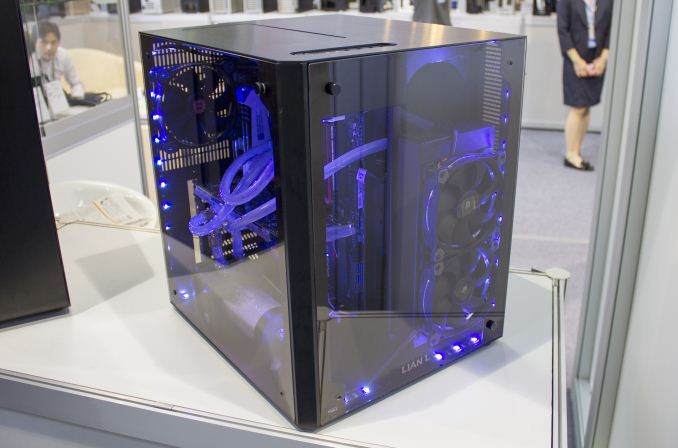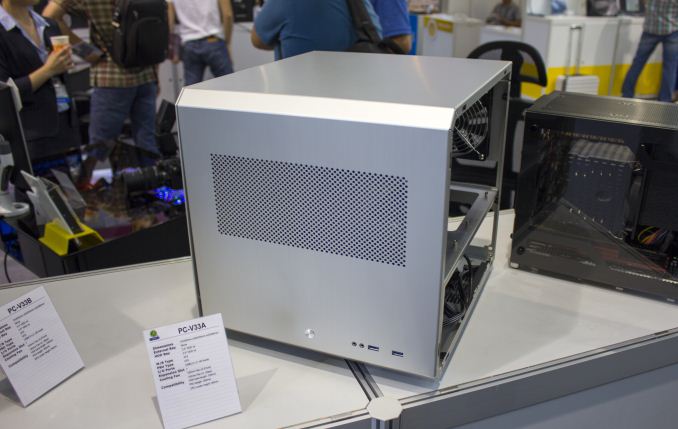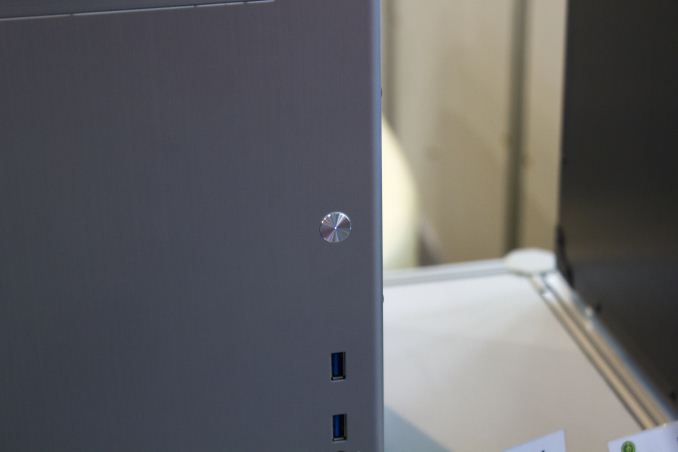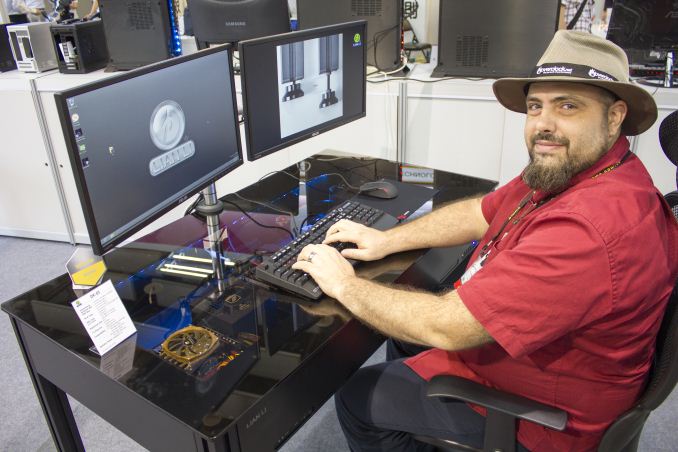Lian Li Computex 2015 Booth Tour
by Kristian Vättö on June 11, 2015 3:50 AM EST- Posted in
- Cases/Cooling/PSUs
- Lian Li
- Computex 2015

Lian Li had close to a dozen new or prototype-level cases on display at Computex. I've added most in the gallery at the end of this post, but I'll go through a few of the highlights here as well.
The first one is the PC-V33A, which is a box-like case in which the motherboard is mounted horizontally. The top cover is made out of single piece of aluminum, but it opens up for easy installation.
The case above is more of a conceptual prototype where Lian Li is playing around with a taller case design. Instead of having hard drive bays next to the motherboard, there's room for four hard drives in the top chamber, which allows for better airflow in the main chamber.
One of the more down to earth designs is the PC-K621, which is also Lian Li's first non-aluminum case. Traditionally Lian Li has kept the Lancool brand for value cases, but it seems that the company is trying to consolidate everything under a single brand now. The PC-K621 is made out of steel and plastic, but it does feel very sturdy and despite the fact that the front panel is made out of plastic, it has a metal-like look in it. Pricing will be about $70, so while it's not exactly a value case it's still considerably cheaper than the rest of the Lian Li cases.
One minor change Lian Li has made to its cases is changing the power button material from plastic to aluminum. The company received many complaints of the power button not having the same feel as the rest of the case, so as any respectable company Lian Li listened to its customers and made the change.
And obviously no Lian Li booth tour is complete without the computer desk case. Lian Li has modified the design a bit so that one can now easily sit with legs under the table, which was one of the issues the earlier cases had (note: that's Kip Hartwell, Lian Li's marketing rep, in the photo, not me). The desk is still expensive, though, and Lian Li doesn't really have any plans of making a value model, but it's a relatively small niche anyway.
Check out the gallery above if you're interested in seeing what else Lian Li had to offer!





















15 Comments
View All Comments
at80eighty - Thursday, June 11, 2015 - link
initially i was a bit put off by cube casings, but they are starting to grow on me - the idea of keeping core components available for interference free cooling is pretty great.Zak - Thursday, June 11, 2015 - link
Unless you do some high overclocking this really doesn't matter in the life of average computer geek. The cooling advantage is minimal for a standard setup, even with multiple GPUs.Impulses - Thursday, June 11, 2015 - link
Ehh, that's a pretty broad/firm assertion, it's definitely gonna make a difference vs some of the more cramped designs with an S path for airflow and lots of grills, doors, drives, etc in the way...ClockHound - Thursday, June 11, 2015 - link
These double-decker cube designs are not just for cleaner airflow - which is great in any situation - less restriction, means intake fans can spin lower, with less noise. Who wouldn't want less noise with lower temps?The big attraction is the ease of access for tweaking/experimenting. Unless you're against the tweaker ethos - which on an enthusiast site, spoils the fun.
And, as proven on many StarTrek episodes, a cube is the most space efficient design. Resistance is Futile. The era of the tedious towers is ending. The Cubists are coming.
Just not soon enough, Lian Li, damnit! Have to continue the endless HAF XB mods. ;-)
Psycownage - Thursday, June 11, 2015 - link
I am curious about the mini-itx case in the background of the PC-V33A picture, any more shots / details?creed3020 - Thursday, June 11, 2015 - link
It is the PC-Q10. There is an additional shot of it in the galleryhttp://www.anandtech.com/Gallery/Album/4431#3
hbsource - Thursday, June 11, 2015 - link
So their previous table prevented you from easily sitting with your legs under the table?I mean, I'm no table expert but there aren't a whole load of requirments for a table. I'll have a go at listing them:
- Must not fall over.
- Must be level.
- Must be able to get legs under.
close - Thursday, June 11, 2015 - link
Well you could but it was relatively uncomfortable. I'm a tall person so even when I stretched my legs while sitting on the chair it wasn't that pleasant as the lower edge of the table was too close for comfort. I'd always have my legs against that edge no matter how I lowered the chair.Basically the design was too thick. Either the bottom part was too low pressing on the legs or the top part was too high forcing you to keep your arms a bit too raised. This of course depending on the persons and the chair's height.
meacupla - Thursday, June 11, 2015 - link
And this is why most tables use less than 2" thick boards where the designers expect you to be sitting.Zefeh - Thursday, June 11, 2015 - link
I didn't realize Angel Batista works for Lian-Li/Anandtech >_>